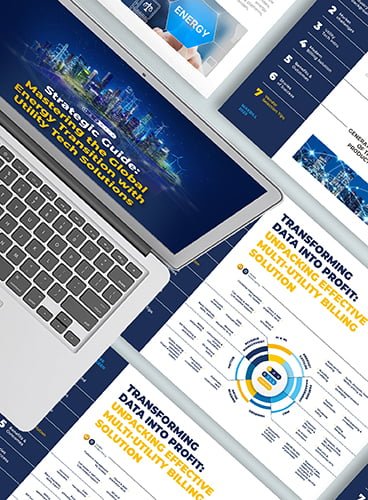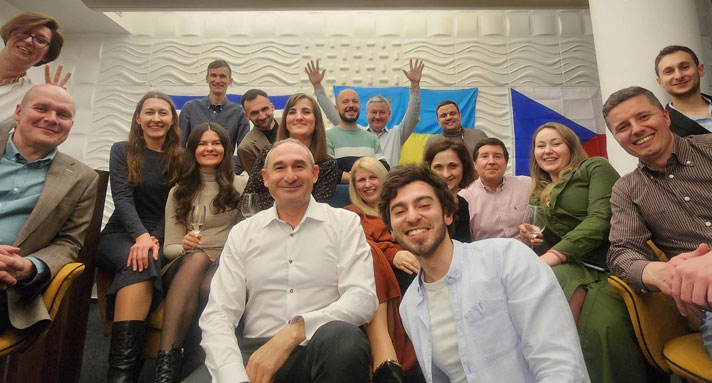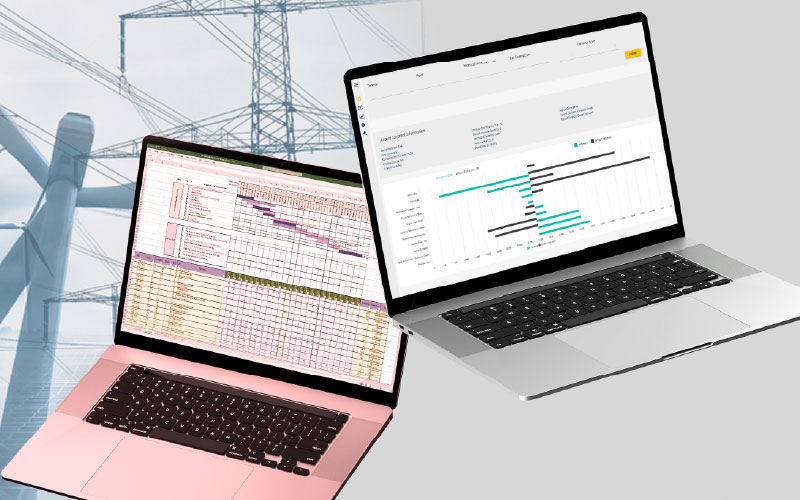The energy and utility sectors have a renewed sense of urgency regarding digitalisation as new regulatory expectations (24-hour switching) and reporting requirements (energy efficiency reports) arise. Besides, there is also a downward pressure on operational costs and changing service level demands.
Climate change is another reason businesses need to prioritise digital transformation again. Service suppliers need to provide real-time insights into the environmental and carbon impacts of their performance (ESG reporting). Legacy systems, in many cases, cannot support the upcoming market requirements, making companies think about whether to undergo a digital update or a complete system overhaul.
Whatever the current need is, there’s a job title in the company that’s in charge of these processes. So, in this piece, we help utility CIOs discover the pitfalls of DT and provide helpful recommendations that can make the whole transition as smooth and successful as possible.
Let’s get closer to it.

The true meaning of digital transformation in the utility sector now and the role of utility CIOs

“Digital is a non-functional requirement. It’s about building capability.”
– stated one technology leader.
Performing the entire digital revamp is risky and, let’s be honest, not necessary. Building business capacities makes more sense, … but which one exactly? Based on the Gartner 2024 survey, these are:
1. Service-to-cash capacities.
Utilities are moving beyond traditional meter-to-cash models to include service-based revenue streams. To meet changing customer expectations and evolving business models, utilities must adopt service-to-cash capabilities, such as offering new services like dynamic pricing, electric vehicle charging, and real-time energy management.
2. Increasing operating margins by aligning the CRM with evolving business models.
Aligning the Customer Relationship Management (CRM) system with new utility business models allows utilities to improve operational margins. This alignment must include support for dynamic pricing, EV charging, aggregation models, and compliance with changing regulations, ensuring that utilities can respond to customer demands while maintaining profitability.
3. Prioritizing a cloud-first strategy with a composable architecture.
By adopting a cloud-first approach, utilities can enhance data security and operational agility. A composable architecture enables utilities to integrate systems more easily, allowing for real-time data processing, secure transactions, and quicker adaptation to technological and regulatory changes.
Related:
Cloud for Utilities: Migration Strategies & Value for Business
4. Adopting cloud-based and SaaS deployments for scalability.
Transitioning customer information systems (CIS) to cloud and Software as a Service (SaaS) models can offer utilities the ability to handle near-real-time data, ensuring improved service delivery and more efficient revenue generation.
5. Integrate AI and ML and automation tools into the internal system.
Utilities should incorporate task-focused AI/ML, robotic process automation, and chatbots into their system. These technologies can improve operational efficiency, but CIOs must establish clear governance structures and policies to fully capitalize on these embedded AI models. Without well-defined processes, utilities may struggle to unlock the full potential of these tools.
Related:
Machine Learning Debt Prediction Model for Utility Debt Recovery.
6. Introducing more efficient elements of customer engagement and experience.
CIOs must evaluate whether their system supports crucial elements of customer engagement, particularly in areas like net billing for electric vehicle (EV) charging. This ensures the system can meet modern customer expectations and regulatory demands, helping utilities retain customers and manage energy consumption more efficiently.
7. Verification of the current product catalogue in terms of creating seamlessly bundled services.
To stay competitive, utilities should assess if their current product catalog supports the creation of bundled services. This capability allows utilities to offer comprehensive packages, such as combining energy services with additional offerings like internet or mobile connectivity, which can enhance customer satisfaction and open new revenue streams.
Related:
More choice and enhanced value for your customers with MaxBill Product Catalogue
8. Supporting dynamic pricing models and personalised pricing strategies.
With the growing complexity of utility markets, CIOs must develop capabilities to support dynamic pricing models, such as time-of-use or real-time pricing. Enhancing customer engagement through personalized pricing strategies and a wider array of service options is crucial for customer retention, especially in competitive markets.
Related:
Innovative and Competitive Pricing Strategies for Energy and Utility.
Key processes utility CIOs can leverage to make the digital transformation preparation a success

- Ensuring that a digital pilot will be a success and has the potential for scaling up.
Energy and Utility CIOs should focus on the early success of digital transformation pilots by preparing for future scaling. Often, digital projects show potential during the pilot phase, but organizations struggle to expand them across the company due to barriers, such as cybersecurity concerns. CIOs must actively plan for scalability from the beginning to fully capitalise on the benefits.
- Doing checks and balances, assessing systematic risks, etc.
Necessary checks and balances include evaluating the readiness of the organisation’s infrastructure and assessing potential risks that may arise from integrating new digital tools or technologies.
Systematic risk assessments help identify vulnerabilities, such as cybersecurity threats or operational disruptions, ensuring that the digital transformation process proceeds smoothly and securely. By addressing these risks early, CIOs get their organisations ready for a successful and sustainable digital overhaul.
- Building the bridge between operations and cyber security functions.
There’s a cultural gap between operations and cybersecurity teams that must be closed for successful digital transformation. Both teams need to better understand each other’s roles and objectives, creating alignment between operational goals and security needs. This involves improving communication and cooperation to ensure that digital initiatives are implemented securely and effectively.
- Deblocking cybersecurity blockers for other teams.
E&U CIOs must be aware of the cybersecurity risks associated with digital transformation and work to remove cybersecurity obstacles that can hinder the progress of other teams. This involves not only understanding the cyber threat landscape but also making sure that cybersecurity measures support rather than impede digital innovation.
- Addressing questions about SaaS or cloud-based solutions not being capitalisable costs and showing positive business outcomes in the long run.
Regulatory frameworks sometimes categorize SaaS and cloud solutions as operational expenses, which can discourage their use. However, CIOs can demonstrate the long-term value of these investments by showing the positive impact they can have on business efficiency and sustainability, thus overcoming the initial financial reluctance.
- Starting with tactical point solutions across siloed business functions.
CIOs can initiate digital transformation by implementing targeted digital solutions in specific business areas. For instance, automating utility billing processes can lead to improved accuracy and transparency, setting a foundation for broader transformation efforts.
- Ensuring high levels of integration and automation across OT and IT environments.
Real-time optimization of operations requires the integration of operational technology (OT) and information technology (IT) environments. Utility CIOs must ensure these systems work together seamlessly, using automation to enhance efficiency and allow for dynamic adjustments in operations and resource management.
- Undertaking a review of the capabilities that teams are accessing on a regular basis to ensure the full value of licenses is being realised.
Utility CIOs should periodically review the tools and capabilities their teams use to ensure they are fully leveraging the features provided by their software licenses. Many enterprise systems offer underutilised functionalities that could unlock additional value without extra investment.
- Leaning on technology and integration partners, when it’s about the product’s implementation.
CIOs can benefit from collaborating with technology and integration partners, who can provide guidance and help to overcome challenges in digital transformation. Partners can clarify misconceptions about new technologies and assist in achieving smoother implementations, making the transformation process more manageable and effective.
The very next step is to find the vendor that provides the required capabilities and guides through the implementation process. The good news here is that CIOs can use this list to assess vendor capabilities, such as for operations deliverables (for example, customer support or help desks).
How should Utility CIOs assess potential vendors for their organization

CIOs should assess vendors based on the range of capabilities they provide, such as customer account management, energy billing, payments, credit management, and customer engagement.
It’s important to match these functional needs with the organization’s requirements. If gaps exist, vendors should offer third-party solutions to complement their offerings. Without further ado, here’s a must-have list that might be helpful when surveying vendor options:
- Flexibility in deployment options
Evaluate whether vendors offer flexible deployment options, including on-premises, SaaS, or cloud-based systems. CIOs need solutions that support API-based integration and real-time event streaming to facilitate operational agility and scalability.
- Vendor expertise in regulated and competitive markets
Vendors should demonstrate their ability to meet the needs of both regulated and competitive utility markets. In regulated environments, vendors should provide robust customer service delivery capabilities, while in competitive markets, emphasis should be placed on customer churn analysis, profitability, and comprehensive data exchange with multiple market participants.
- Total experience and customer-centricity
CIOs should look for vendors that enhance the total experience (customer, employee, and user experiences) through digital engagement tools like self-service portals and multichannel interactions. This focus on customer-centricity is crucial for driving retention and improving overall service quality.
Related:
Superior utility customer experience by transforming into a customer-centric utility.
- Security, scalability, and compliance
Assessing the vendor’s ability to provide a secure and scalable solution is critical. Cloud-based platforms should come with built-in security features, frequent updates, and compliance with privacy standards. This ensures that the system remains reliable and secure while reducing the cost of ownership.
- Geographic presence and support
It’s essential to consider the vendor’s regional presence and support capabilities. This includes evaluating whether the vendor can provide adequate operational support (e.g., help desks) in the CIO’s geographic region, especially if it’s underserved.
If you’re an energy and utility CIO in your organisation looking to optimise processes in your organisation, let us know what we can do for you!
































